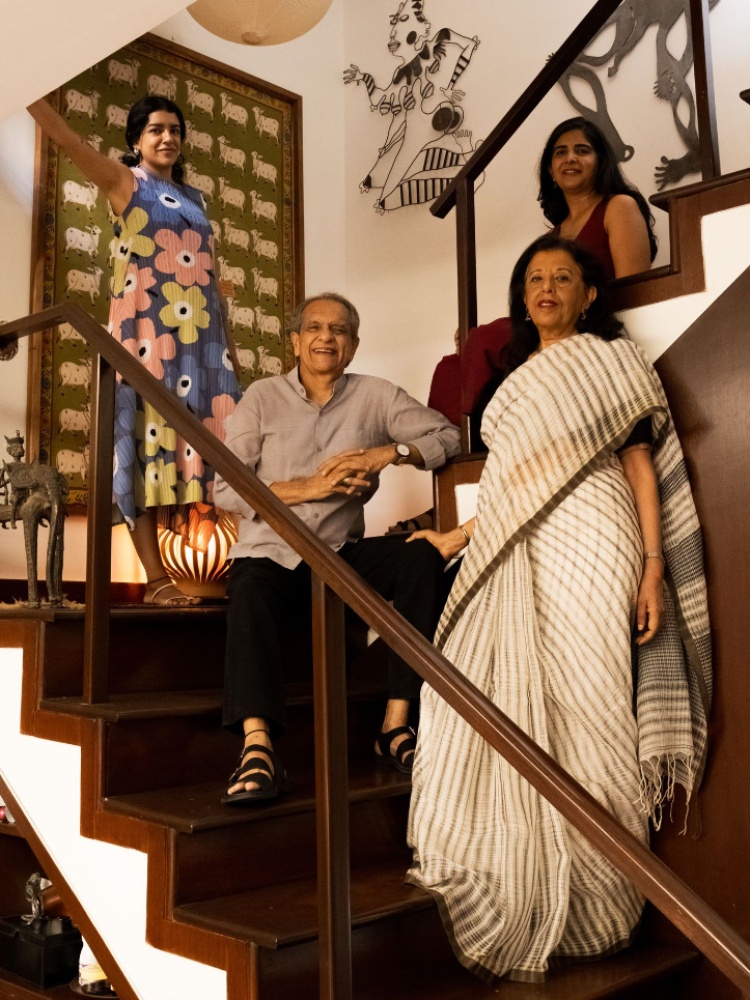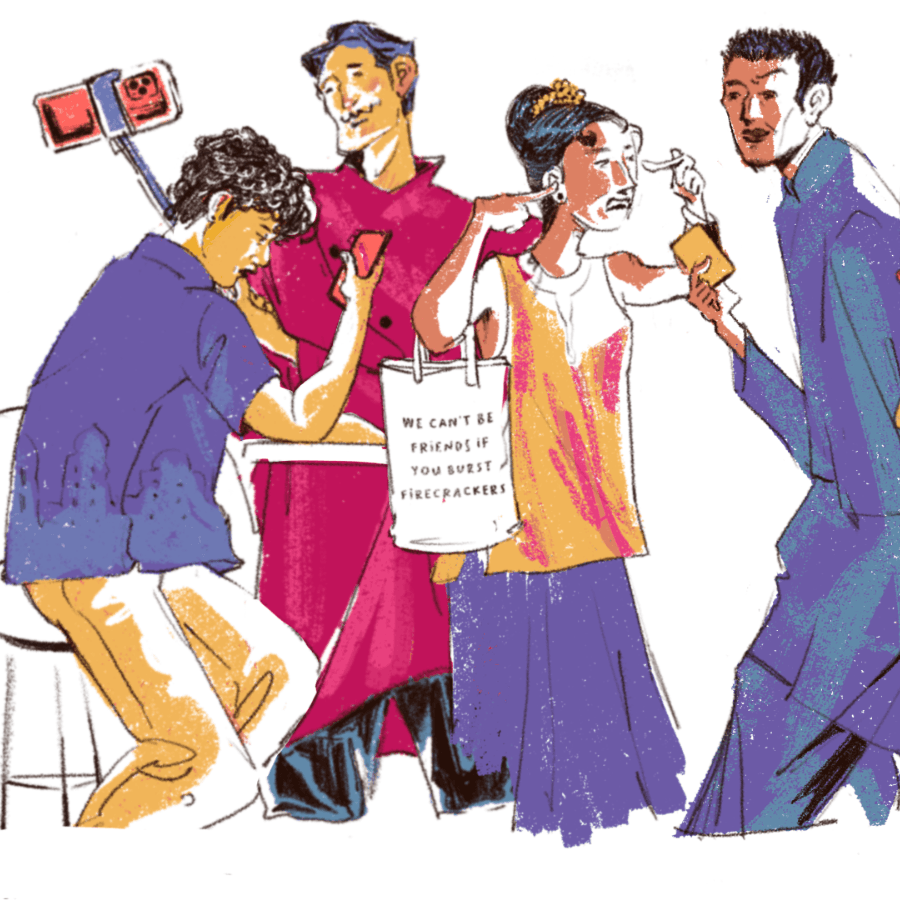When multimedia artist Tarini Sethi and her sister, production designer Yasmin Sethi, were growing up, they often spent their school holidays at their father’s handmade paper factory. Nitin Sethi’s Sukriti Inprint was well-known in New Delhi for making invites and greeting cards that were sent to dignitaries all over the world on behalf of the Prime Minister’s Office. But for the girls, the factory was a playground: they looked on in delight each time the industrial paper cutter neatly sliced through the giant stacks of paper. Their father encouraged their fascination, supplying them with paper, ink, and glue to cut and tear, paste and play with as they wished.
“Creativity can be suppressed so easily if you don’t have people at home encouraging you, having faith in you,” shares Tarini, who, now 34, is one of India’s most prolific contemporary artists. She’s created sculptures in stainless steel, installations out of wooden puppets and their shadows, Escher-esque drawings that you could get lost in, and paintings so intricate they’re practically optical illusions. Her art isn’t easy to label, but it’s undeniably evocative; she’s showcased her work at Chemould Prescott Road in Mumbai, Art Basel in Hong Kong, Trimarchi in Argentina, and Rajiv Menon Contemporary in Los Angeles. This month, her art debuts in Tokyo’s Galerie Geek/Art, which will be on view until September end. She also happens to be a curator with a keen eye: as the founder of The Irregulars Art Fair and its accompanying periodical, The Irregular Times, she champions up-and-coming artists from across the country. Now, seated in her family home in New Delhi with Nitin, Yasmin, and her mother, the craft doyenne Ritu Sethi, she’s contemplating the very essence of creativity. “Look, what use was my creativity if I wasn’t born into this family?”
A quick look around the Sethi home reveals that it is a space where creativity is definitely encouraged, perhaps even steered. The house is a perfect marriage of Bauhaus-inspired lines with lush green Mediterranean colours, washed in natural light and swathed in a palette of greens and browns. The family’s own artistic creations serve as decoration: Tarini’s stainless steel figurative sculptures, a recycled leather sofa and metal floor lamps designed by Nitin, books and curios collected from each member’s travels.

Multimedia artist Tarini Sethi, whose work has been showcased in Hong Kong, Argentina, and LA, makes her Tokyo debut at Galerie Geek/Art this month
Until recently, all four members of the family lived together in this home in the Asian Games Village Complex (Yasmin is now married and lives in Mumbai), and each managed to carve their own creative path. Ritu is an advocate for artisan communities through her organisation the Craft Revival Trust; Nitin is a product designer and exporter of paper, furniture, and mixed media accessories through his brands Vivaldi Leather and Slomotion. Yasmin, 38, has been the production designer for notable projects in the film and OTT space, including The Family Man, The Sky is Pink, and The White Tiger.
The two girls grew up thinking that creativity was simply a way of life. Of course, Ritu and Nitin’s approach to parenting too was quite unique. Nitin says he was aghast when Tarini decided to study political science at the prestigious Lady Shri Ram College for Women for her undergraduate degree, and only felt better when she went to the Pratt Institute in New York to study art; Yasmin studied product and industrial design at Central Saint Martins in London.
“It was only when I grew older that I realised we were different,” laughs Yasmin, although the sisters are quick to clarify that their creative upbringing did come with its own rules. Nitin taught them the concept of negative and positive spaces in art by insisting that they left no blank space while sketching, and Ritu would make them write an original story every day. “None of our friends were doing these crazy exercises, but mum was very strict,” laughs Tarini, quickly adding: “All said and done, it fuelled our imagination.”
What’s interesting is that the couple, even then, made it a point to monitor screentime, and ensure their children got bored. I’m reminded of my recent conversation with stand-up comedian Abish Mathew, who said that boredom in childhood fuelled his creativity. Julia Cameron, author of the bestselling book, The Artist’s Way: A Spiritual Path to Higher Creativity, in fact, makes a case for boredom as the most vital exercise that forces the mind to pause, declutter, and think imaginatively.

Tarini Sethi credits her success as an artist to her parents' encouragement of creativity at home
Observation was also key to fuelling the girls’ creativity. While she worked organisations like the government’s Ministry of Textiles and Ministry of Culture, INTACH, and UNESCO, Ritu routinely took her daughters to craft bazaars and museums. Tarini still remembers how impactful it was to watch the potters at work on their wheel, the women embroidering fabric with kantha, the weavers working their loom. Perhaps these and other childhood experiences continue to impact them: Yasmin, who was fond of origami, is now working on a children’s pop-up book. Tarini, on her part, feels that the exposure to art from an early age propelled her to eventually explore themes of intimacy, sexuality, and gender politics in her art. “If I drew four breasts on a figure, my parents would tell me to make six. They taught me to have a voice from the start and that’s what reflects in my work.” Ritu quips: “I didn’t say make six breasts!” There’s a clear camaraderie between the mother and daughter: they may seem to talk over one another, but they listen closely and each one helps the other to articulate their thoughts and fuel conversations further.
Any creative will agree, creativity comes with its idiosyncrasies. Nitin, an early riser, gains his inspiration from nature. His constant companions are a pocket-size notebook and a pencil: “I’m always jotting down observations,” he says, much like Nandalal Bose, one of the leading modernists of Santiniketan, who always had blank postcards and ink pens on him to document the sights and sounds of a place. Nitin’s creative rituals include spending a couple of hours a day with the plants in his home and those of a neighbouring public garden that’s visible from the living room and which, until he restored it, was in a state of neglect. Even the birds are familiar with the man who comes to replenish food in the bird feeder houses and bowls. Yasmin too wakes up early. “I like my quiet time of 45 minutes to an hour with a cup of chai that I make mindfully,” she says. Ritu, given to reading crime thrillers until well past midnight, is a late riser. “Mum and I wake up late,” Tarini laughs, saying that her mother still reprimands her for not having a glass of water in the morning before she drinks a mugful of black coffee. Tarini’s creative process includes listening to horror podcasts while working. “It’s not unusual for the rest of the family to hear loud screams and groaning voices from my room on such days,” she says, listing Tower 4, Left Right Game, and The Edge of Sleep as some of her favourite audio scares.
The family finds decluttering an effective way of removing creative blocks. “It is like removing every extra thought that you don’t need,” says Ritu. To the benefit of the whole family, Tarini happens to also find cooking therapeutic. “We wait for her to cook, she’s so good,” smiles Ritu.

Dinner table conversations at the Sethis are always about art, culture and sharing ideas
While for most families, mealtimes are about discussing work and study schedules, school marks and tuitions, the Sethis’ dinner table is a space to come together to ideate, talk, and engage with one another. Although Tarini confesses that she doesn’t like getting feedback (“Oh, we can’t say anything to her,” says Ritu), Nitin (he briefly published Wanted, a general features newspaper in the 1980s) invariably brings out the results of his experiments with product design for their critical inputs. At dinner, they discuss artists, books, and exhibitions that inspire them—for Nitin, that list includes modernists and contemporary artists such as Madhvi Parekh, Jogen Chowdhury, and Anish Kapoor as well as Sri Lankan architecture. Yasmin and Ritu are currently drawn to the motifs and patterns of Islamic architecture while Tarini leans more towards the work of surrealist artist, Salvador Dali. Until recently, their German shepherd Zara used to quietly snuggle near the dinner table, with Mithu, the family’s rescue parrot, waiting beside her for a serving of green chilli. Zara passed away recently at the age of 17, but her orange plastic ball still holds pride of place on the coffee table. A drawing of Zara, made by Nitin, hangs over a figurative sculpture by Ram Kumar Manna.
It’s the grand old debate—is talent inherited or nurtured? Is it experience and effort, or were you just born with it? Or maybe it’s in the genes? In a letter to his brother, Vincent van Gogh famously wrote: “In order to work and to become an artist one needs love. At least, one who wants sentiment in his work must, in the first place, feel it himself, and live with his heart.” In the house of the Sethis, this sentiment comes alive. In the two hours I spend with the family, we discuss a range of topics—journalling techniques, books, music, art, climate change, gardening, early-morning versus late-morning people, parenting—the last one piquing my interest even more given that I recently adopted my daughter, Meera, who’s seven years old. Ritu, sensing my curiosity, offers advice: “It’s simple. As parents, it is our duty to recognise and encourage the creative talents of our children.”




